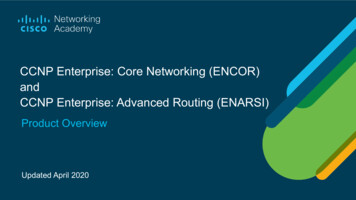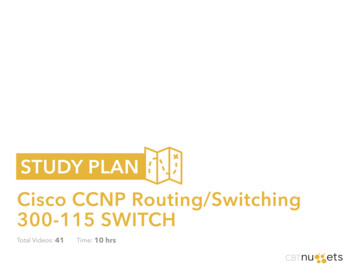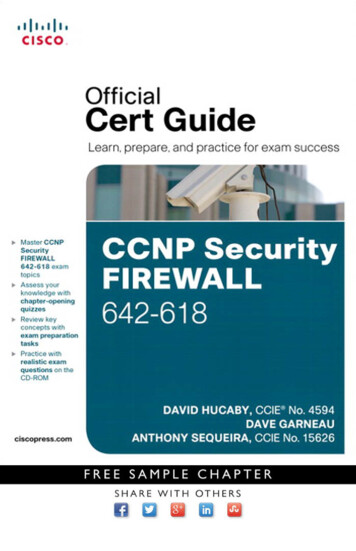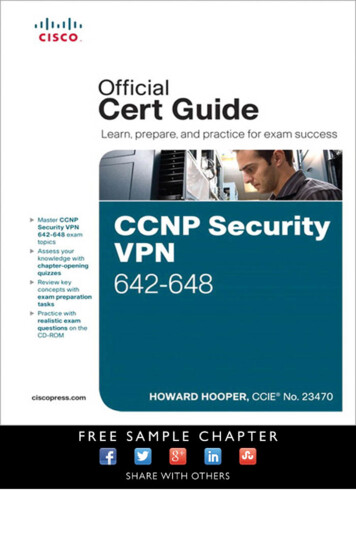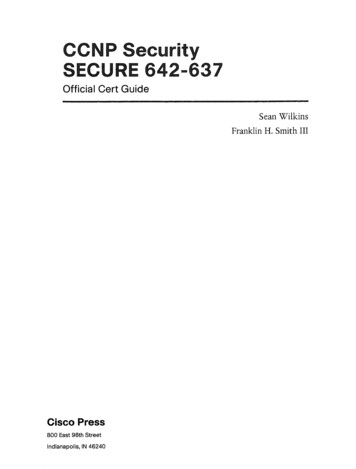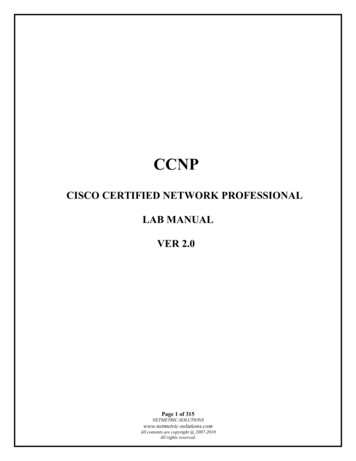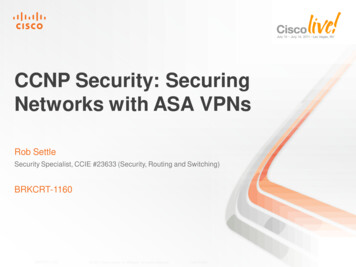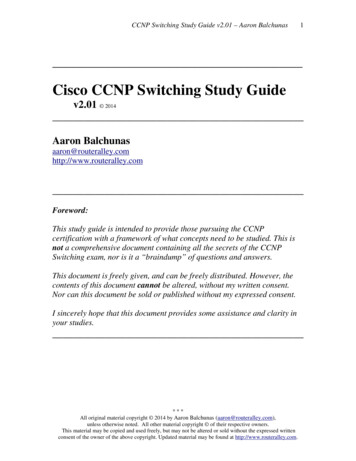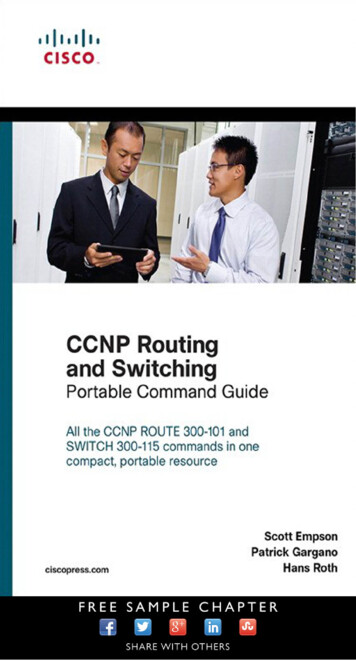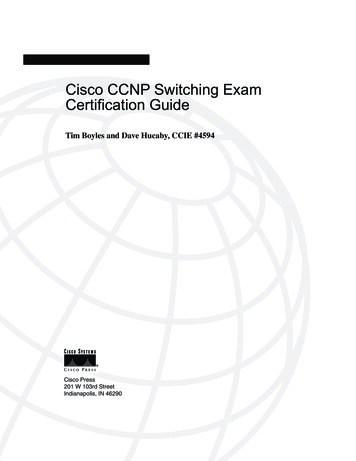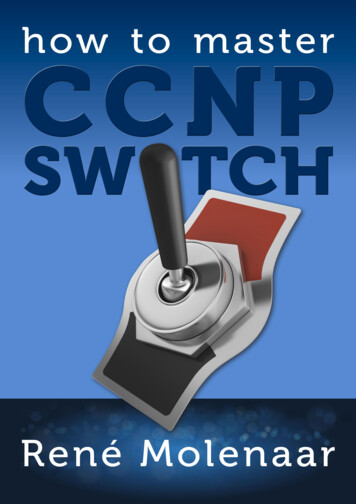
Transcription
How to Master CCNP SWITCHAll contents copyright C 2002-2013 by René Molenaar. All rights reserved. No part of thisdocument or the related files may be reproduced or transmitted in any form, by any means(electronic, photocopying, recording, or otherwise) without the prior written permission ofthe publisher.Limit of Liability and Disclaimer of Warranty: The publisher has used its best efforts inpreparing this book, and the information provided herein is provided "as is." René Molenaarmakes no representation or warranties with respect to the accuracy or completeness of thecontents of this book and specifically disclaims any implied warranties of merchantability orfitness for any particular purpose and shall in no event be liable for any loss of profit or anyother commercial damage, including but not limited to special, incidental, consequential, orother damages.Trademarks: This book identifies product names and services known to be trademarks,registered trademarks, or service marks of their respective holders. They are usedthroughout this book in an editorial fashion only. In addition, terms suspected of beingtrademarks, registered trademarks, or service marks have been appropriately capitalized,although René Molenaar cannot attest to the accuracy of this information. Use of a term inthis book should not be regarded as affecting the validity of any trademark, registeredtrademark, or service mark. René Molenaar is not associated with any product or vendormentioned in this book.GNS3Vault.com – René MolenaarPage 2 of 339
How to Master CCNP SWITCHIntroductionOne of the things I do in life is work as a Cisco Certified System Instructor (CCSI) and afterteaching CCNP for a few years I‟ve learned which topics people find difficult to understand.This is the reason I created http://gns3vault.com where I offer free Cisco labs and videos tohelp people learn networking. The problem with networking is that you need to know whatyou are doing before you can configure anything. Even if you have all the commands youstill need to understand what and why you are typing these commands. I created this bookto give you a compact guide which will provide you the answer to what and why to help youmaster the CCNP exam.CCNP is one of the well-known certifications you can get in the world of IT. Cisco is thelargest supplier of networking equipment but also famous for its CCNA, CCNP and CCIEcertifications. Whether you are new to networking or already in the field for some time,getting a certification is the best way to prove your knowledge on paper! Having said that, Ialso love routing & switching because it‟s one of those fields in IT that doesn‟t changemuch some of the protocols you are about to learn are 10 or 20 years old and still aliveand kicking!I have tried to put all the important keywords in bold. If you see a term or concept inbold it‟s something you should remember / write down and make sure you understand itsince its core knowledge for your CCNP!One last thing before we get started. When I‟m teaching I always advise students to createmindmaps instead of notes. Notes are just lists with random information while mindmapsshow the relationship between the different items. If you are reading this book on yourcomputer I highly suggest you download “Xmind” which you can get for free here:http://xmind.netIf you are new to mindmapping, check out “Appendix A – How to create mindmaps” at theend of this book where I show you how I do it.Enjoy reading my book and good luck getting your CCNP certification!P.S. If you have any questions or comments about this book, please let me com – René MolenaarPage 3 of 339
How to Master CCNP SWITCHIndexIntroduction . 31. Lab Equipment . 52. VLANs (Virtual LANs) . 83. Private VLANs . 494. STP (Spanning Tree Protocol). 645. Rapid Spanning Tree . 1296. MST (Multiple Spanning Tree) . 1627. Spanning Tree Toolkit . 1848. Etherchannel (Link Aggregation) . 2039. InterVLAN routing. 21210. Gateway Redundancy (VRRP, GLBP, HSRP) . 23911. Switch Security . 26812. VoIP and Video on a switched network . 30613. Wireless . 32314. Final Thoughts. 338Appendix A – How to create mindmaps . 339GNS3Vault.com – René MolenaarPage 4 of 339
How to Master CCNP SWITCH1. Lab EquipmentBefore we are going to start on our switching journey we are going to take a look at the labequipment you will need. GNS3 is a very useful tool but it only supports the emulation ofrouters. You are unable to emulate a switch in GNS3 like a Cisco Catalyst 2950, 2960, 3550,3560 or 3750.The closest you can get to emulate a switch inGNS3 is inserting this NM16-ESW Etherswitchmodule in your virtual router.It adds 16 switch ports to your virtual routerand supports basic trunking and spanning-treefeatures. Unfortunately this module is verylimited and it doesn‟t cut it for CCNP SWITCHlabs.Courtesy of Cisco Systems, Inc. Unauthorized use not permitted.So what do we need? My advice is to buy some real physical switches. Don‟t bescared I‟m not going to advise you to buy ultra-high tech brand new switches! We aregoing to buy used Cisco switches that are easy to find and they won‟t burn a hole in yourwallet “If I had eight hours to chop down a tree, I'd spend six hours sharpening my ax” Abraham LincolnWithout further ado here are our candidates:Cisco Catalyst 2950: This is alayer 2 switch that can do all thevlan, trunking and spanning-treestuff we need for CCNP SWITCH.Cisco Catalyst 3550: This is alayer 3 switch. It offers pretty muchthe same features as the 2950 but italso supports routing.Courtesy of Cisco Systems, Inc. Unauthorized use not permitted.If you look at eBay you can find the Cisco Catalyst 2950 for around 50, the Cisco Catalyst3550 is around 100. It doesn‟t matter if you buy the 8, 24 or 48 port model. Not too badright? Keep in mind you can sell them once you are done with CCNP without losing (much)money.GNS3Vault.com – René MolenaarPage 5 of 339
How to Master CCNP SWITCH3550SwitchA130/140/FaFaFa0Fa0/Fa0 Fa0/17Fa0/2Fa/Fa0 s is the topology I will be using throughout (most of) the book and I advise you to buildit so you can do all the labs in this book by yourself. I did my best so you don‟t have to recable that often. We need one Cisco Catalyst 3550 because it can do routing; the other twoCisco Catalyst 2950 switches are sufficient for all the other stuff.What about other switch models? Anything else we can use? Sure! The Cisco Catalyst 2960 is the successor of the Cisco Catalyst 2950, it‟s a great layer2 switch but more expensive. The Cisco Catalyst 3560 is the successor of the Cisco Catalyst 3550, it also offerslayer 3 features and it‟s quite more expensive around 300 on eBay. The Cisco Catalyst 3750 is a layer 3 switch that is suitable for CCNP SWITCH.I don‟t recommend buying the Cisco Catalyst 2960 because it doesn‟t offer anything extracompared to the Cisco Catalyst 2950 that‟ll help you beat the exam.The Cisco Catalyst 3560 does offer two features that might justify buying it: It can do private vlans which is a CCNP SWITCH topic. It‟s impossible to configure iton a Cisco Catalyst 3550! It‟s a small topic though and personally I don‟t think it‟sworth the additional 200 just to configure private vlans.QoS (Quality of Service) is different on the Cisco Catalyst 3560 compared to theCisco Catalyst 3550. If you intend to study QoS in the future I would recommendbuying this switch. You won‟t need it for the CCNP SWITCH exam.GNS3Vault.com – René MolenaarPage 6 of 339
How to Master CCNP SWITCHAre there any switches that you should NOT buy? Don‟t buy the Cisco Catalyst 2900XL switch; you‟ll need at least the Cisco Catalyst2950 switch. Many features are not supported on the Cisco Catalyst 2900XL switch.Don‟t buy the Cisco Catalyst 3500XL switch, same problem as the one above.If you studied CCNA you probably know the difference betweenstraight-through and crossover cables. Modern switches andnetwork cards support auto-sensing so it really doesn‟t matterwhat kind of cable you use.If you are going to connect these older switches to each othermake sure you buy crossover cables since they don‟t supportauto-sensing!I also like to use one of these. It‟s a USBconnector with 4x RS-232 serial connectorsyou can use for your blue Cisco consolecables to connect to your switches.It saves the hassle of plugging andunplugging your console cable between yourswitches.The one I‟m using is from KÖNIG and costsaround 30. Google for “USB 4x RS-232”and you should be able to find somethingsimilar.In my topology picture you saw that I have three computers connected to my switches. Formost of the labs I‟m only using those computers to generate some traffic or send somepings so don‟t worry if you only have one computer, you can also use a cisco router if youhave one.GNS3Vault.com – René MolenaarPage 7 of 339
How to Master CCNP SWITCH2. VLANs (Virtual LANs)In this chapter we will take a look at the configuration of VLANs, Trunks, Etherchannels andPrivate VLANs. If you studied CCNA then the first part of this chapter should be familiar toyou.Let‟s start off by looking at a picture of a ngineeringHumanResourceSalesResearchLook at this picture for a minute, we have many departments and each department has itsown switch. Users are grouped physically together and are connected to their switch. Whatdo you think of it? Does this look like a good network design? If you are unsure let me askyou some questions to think about: What happens when a computer connected to the Research switch sends a broadcastlike an ARP request?What happens when the Helpdesk switch fails?Will our users at the Human Resource switch have fast network connectivity?How can we implement security in this network?Now let me explain why this is a bad network design. If any of our computers sends abroadcast what will our switches do? They flood it! This means that a single broadcast framewill be flooded on this entire network. This also happens when a switch hasn‟t learned abouta certain MAC address, the frame will be flooded.GNS3Vault.com – René MolenaarPage 8 of 339
How to Master CCNP SWITCHIf our helpdesk switch would fail this means that users from Human Resource are “isolated”from the rest and unable to access other departments or the internet, this applies to otherswitches as well. Everyone has to go through the Helpdesk switch in order to reach theInternet which means we are sharing bandwidth, probably not a very good ideaperformance-wise.Last but not least, what about security? We could implement port-security and filter on MACaddresses but that‟s not a very secure method since MAC addresses are very easy to spoof.VLANs are one way to solve our problems.Two more questions I‟d like to ask you to refresh your knowledge: How many collision domains do we have here?How many broadcast domains do we have here?Each port on a switch is a separate collision domain so in this picture we have a LOT ofcollision domains more than 20.What about broadcast domains? If a computer from the Sales switch would send abroadcast frame we know that all other switches will forward it.Routers don‟t forward broadcast frames so they effectively “limit” our broadcast domain. Ofcourse on the right side of our router where we have an Internet connection this would beanother broadcast domain so we have 2 broadcast domains here.3rd Floor2nd Floor1st FloorResearch EngineeringSalesWhen you work with switches you have to keep in mind there‟s a big difference betweenphysical and logical topology. Physical is just the way our cables are connected while logicalis how we have configure things „virtually‟. In the example above we have 4 switches and Ihave created 3 VLANs called Research, Engineering and Sales. A VLAN is a Virtual LAN soit‟s like having a “switch inside a switch”.GNS3Vault.com – René MolenaarPage 9 of 339
How to Master CCNP SWITCHWhat are the advantages of using vlans? A VLAN is a single broadcast domain which means that if a user in the research VLANsends a broadcast frame only users in the same VLAN will receive it.Users are only able to communicate within the same VLAN (unless you use a router).Users don‟t have to be grouped physically together, as you can see we have users inthe Engineering vlan sitting on the 1st, 2nd and 3rd floor.In my exa
CCNP is one of the well-known certifications you can get in the world of IT. Cisco is the largest supplier of networking equipment but also famous for its CCNA, CCNP and CCIE certifications. Whether you are new to networking or already in the field for some time, getting a certification is the best way to prove your knowledge on paper! Having said that, I also love routing & switching because .
